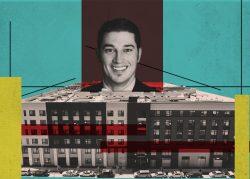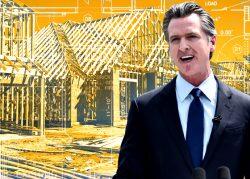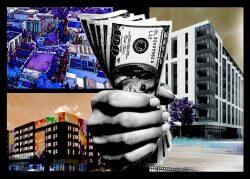Emeryville Mayor John Bauters has never been shy on Twitter, often posting multiple times a day and earning a reputation for calling out other Bay Area cities for failing to meet their state-mandated housing creation goals. Then, days into 2022, the bike and public transit advocate tweeted: “Every time someone tweets about how they hate sharing the road with bicyclists I choose another street parking space to eliminate.”
The tweet took Bauters to the next level of social media influence, with more than 2,000 retweets and over 26,000 likes. That’s about two likes for every person who lives in the bay-fronting town sandwiched between Oakland and Berkeley, according to Census data, a population that has more than doubled since the 1990s.
Suddenly Bauters began getting requests from people across the country to run for mayor of their small towns, while others tweeted that they couldn’t believe Bauters was “an actual mayor of a real American city.”
It’s not the first time people have been dubious of the 42-year-old’s bonafides, especially as he often performs his mayoral duties in a jean jacket, button-down shirt and one of his approximately 80 bow ties.
He even owns a sash that says, “THE ACTUAL MAYOR OF EMERYVILLE” from a Halloween bash at Pixar, which is based in Emeryville, also home to Peet’s Coffee corporate headquarters and a growing life sciences cluster.
Emeryville also has earned a reputation as a place where housing of various sorts gets built.
While as many as 27 cities nearby appeal state-mandated targets for new housing, Emeryville has raised its hand to go above and beyond requirements by 50 percent, setting a goal of 2,700 units instead of 1,800 by 2031. It’s more than a goodwill gesture–the extra effort would give the city a “pro-housing” designation and an advantage in applying for state housing funds.
In an interview while ambling down the city’s newly improved Greenway—a stroll that culminated at an eight-acre redevelopment site that was home to a Sherwin-Williams factory for a century and will soon have 500 rentals, a new city park and ground-floor commercial space—Bauters certainly seemed mayoral, saying hello to every single person he saw along the way. He talked candidly about understanding those who only think of Emeryville as “the land of big box stores” and why his new higher profile doesn’t mean he has designs on higher office.
Why doesn’t Emeryville seem to have the political pushback against building housing that we often see in the Bay Area?
A lot of politicians just capitulate to, “Oh, they don’t want us to build that housing or they don’t want to put the bike lane in. So I can’t do it, there’s too much opposition.” Sometimes the opposition is really loud and it isn’t representative of the majority.
It’s also about going out and finding the people who don’t come to your meetings. You have to do the engagement piece proactively, and then also when people oppose something, you have to educate them. That’s the hard part that makes a lot of politicians squeamish. And sometimes you just have to tell people, “You elected me to use my best judgment and, as a leader in your community, I’m asking you to trust me that this is something we need to try.”
You’ve been re-elected, so that political strategy seems to be working out. But when you first ran for city council in 2014, only two years after moving to Emeryville, you lost. What made you want to run and then try again?
The first time I had essentially no endorsements or institutional support. I did it because I really felt like the city needed some people in leadership who were willing to take it to a new place on the livability space. The city had been an industrial center for most of its life and when industry kind of faded away a cohort of council members in the late eighties and early nineties came on and really turned this into a commercial center.
They did what they felt was necessary to economically support the city as industry was dying out. We still have an industrial zone and we still have people who manufacture things here, but there was an oversubscription to industrial space that was converted into retail. I understand why people are like, “Oh, the land of big box stores.” I get it because that’s what we built for a long time.
Now you have a different cohort of council members and it’s a relatively younger cohort. In terms of the five of us, two are younger than me and we have this unique space where there’s jobs, biotech, life sciences, work innovation. People can walk and bike to their jobs, so our big goals are building more housing in the space we have and creating that very livable environment.
Small cities typically don’t deliver as many projects as we do in the timeline that we’re doing it. We have the energy and the desire to transform the space and we don’t know why we would need to ask residents to wait 10 to 15 years.
Why take other Bay Area cities to task on social media for approving things very slowly or not at all?
I just want them to stop and think about what they’re saying and whether they really believe that what they’re saying is actually the product of listening to their communities. I think that if they spent the actual time in the community that we do they would find that it’s maybe not the case.
There’s a whole cohort of people, and it’s not just elected officials, who feel like the status quo is all we can do. There’s no imagination for a better community, or in some cases, it’s, “I got mine already, so I don’t want a new neighbor.” That actually creates all the other types of costs and social problems that the very same people get upset about. People tell us, “I don’t want to see another guy sleeping under the Powell Street overpass.” Well, neither do I, but we’ve underproduced in California on housing for over a decade now.
On the other side, you have people who go, “We should only build one hundred percent affordable housing.” Well, that’s a great idea but the people who say that either don’t understand how housing finance works or they’re in denial of it. Or, truthfully, they don’t actually want it, but they want it to look like they want it.
If there’s an ample amount of supply for people coming into the community, you’re less likely to have your lower-income people gentrified out of the community. So we allow market rate development but we make it really clear and predictable from day one in our development guidelines: This percentage of what you will do will be affordable. This percentage of your construction value will be added as a fee to contribute to public art. This percentage of your construction value will go to a community benefits program for transportation, infrastructure projects, community parks, and wellness programs. We basically just tell the developer up front: “Welcome to our community. This is the expectation.” And people come and build here because developers just want predictability.
We get the types of partners we want now, whereas before we had people in this town who own big properties who have no engagement with the council and the city. They got what they wanted and needed. They make their money. But the people we’re bringing in now are people who we have a relationship with.
What lessons can leaders in bigger cities take from Emeryville’s example?
We were underperforming as a city on production of below market rate units before our current council. We passed a housing bond so that we had the money to incentivize projects and we leveraged so much other money into our community. The bond money allows developers to go and be competitive for these other pots of money because the state and these other agencies see the community is invested in this and they want it. So for every dollar we spend, we bring in two to three other dollars from other places easily because we’ve made that initial investment. I sent a thank you letter to the Strategic Growth Council for the $20 million they gave us recently for affordable housing, and some other improvements.
I also think people don’t write enough thank you letters. I guess it goes with the bow ties.
Tell me more about the bow ties. It’s certainly a signature look.
It started when I was a legal aid attorney in Chicago. A social worker asked me to represent an elderly woman in an eviction case. I said I would meet her at the courthouse and she asked how the woman would know who I am. I had this green bow tie from a St Patrick’s Day party and I said, “I’ll wear this green bow tie and when I’m in the courtroom you’ll be able to find me pretty easily.”
She was able to stay in her home and then I did another case for the same social worker and wore the bow tie again. Soon word got out that there’s a guy who wears a green bow tie that will assist low-income people who are being evicted.
One day the judge in the housing court said, “Mr. Bauters, by no means am I a fashion expert, but what is it with you and the green bow tie?” I started to explain myself and he goes, “I really don’t need to know the answer to the question Mr. Bauters, I would just like to ask that you consider finding a second color.”
So I went home that day and I bought a purple one and it began to grow from there.
I wear them any day I’m in public and I love them. If I can spur more people wearing more bow ties, I will be very happy with that accomplishment in my life.
With all the attention you’ve gotten recently, there are some who have been asking you to think bigger. Do you have any interest in higher office?
I’m very flattered, but I have no desire to be a career politician. I don’t even know if I’ll run for re-election and that totally throws people. I believe democracy is something everybody should take a turn doing. I don’t need to do this. We don’t need more white men’s voices holding on to seats forever. We need to elevate women and people of color to have a chance to have a voice and stake in their community.
My experience is that there’s a lot of people who get into office and retaining power is more important to them than fulfilling their own personal goals. Some people give up on that thing they wanted or they water it down or don’t even pursue it because a group of stakeholders tell them, well, you won’t be electable again. And I’m like, “If the city of Emeryville wants to vote for somebody else, they should get what they vote for.” They don’t have any power over me and that’s the most liberating part about my job. So I think most of the support I have is because people want officials who have values and stand by them and don’t care if they get reelected.
Read more



